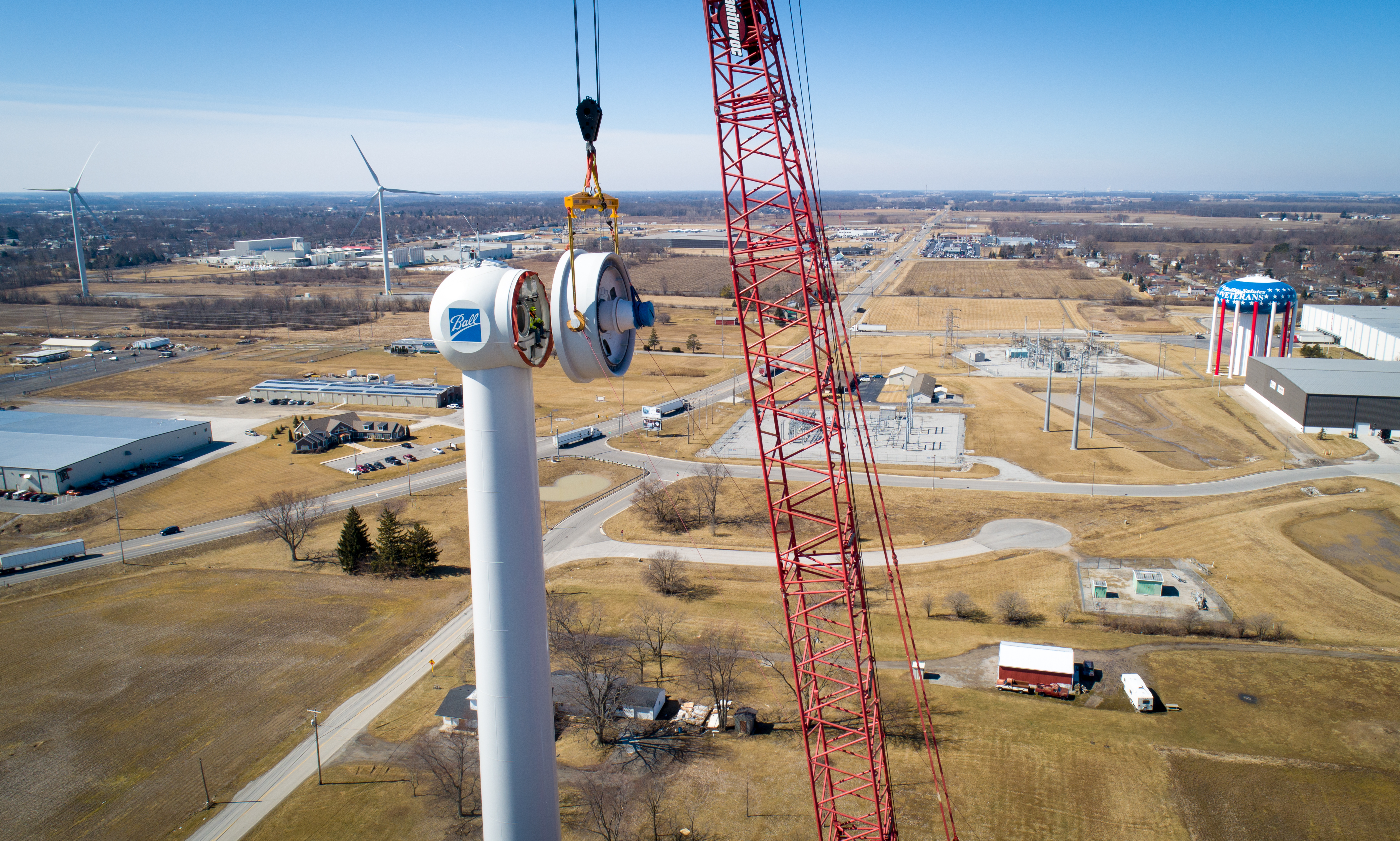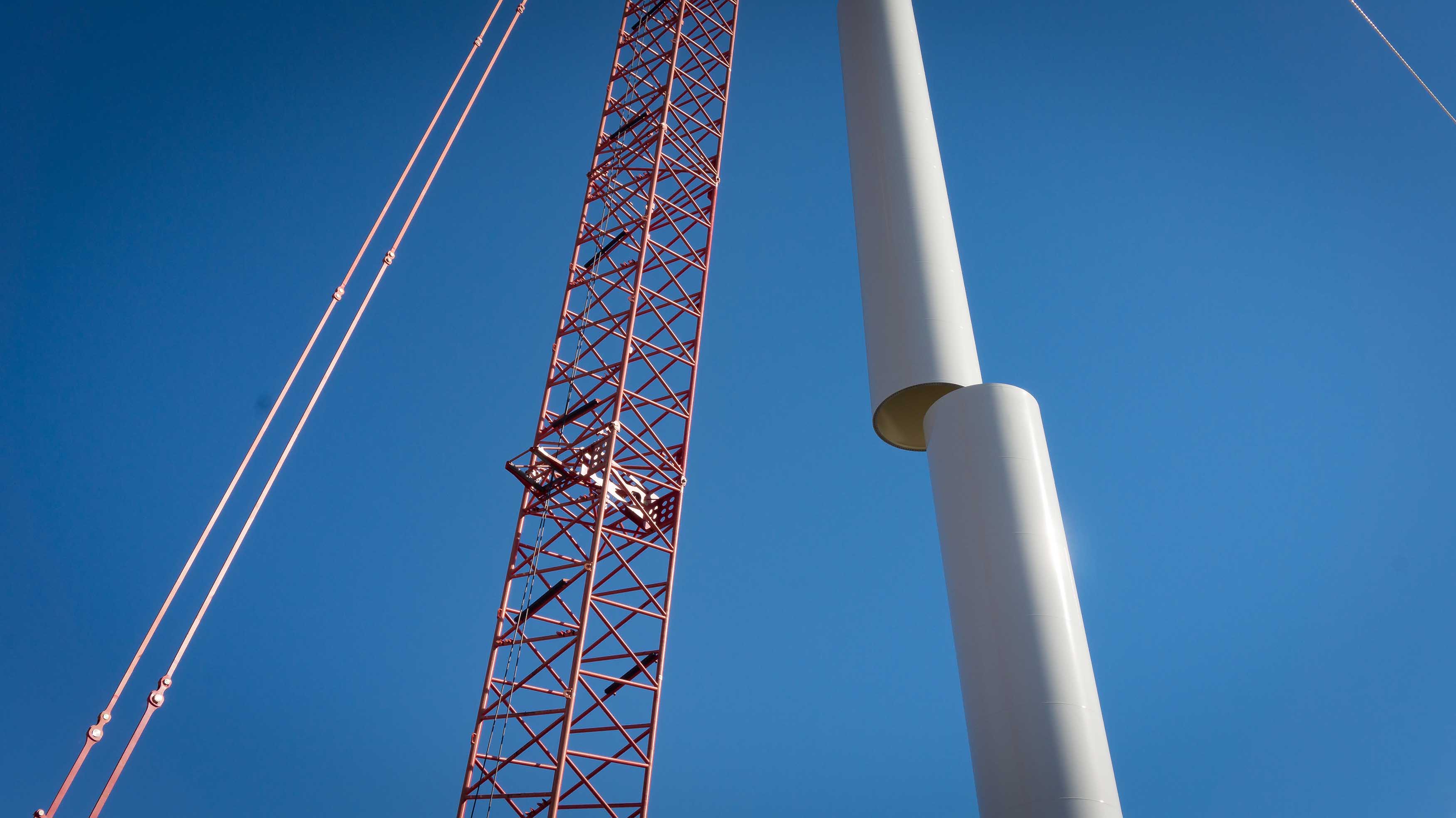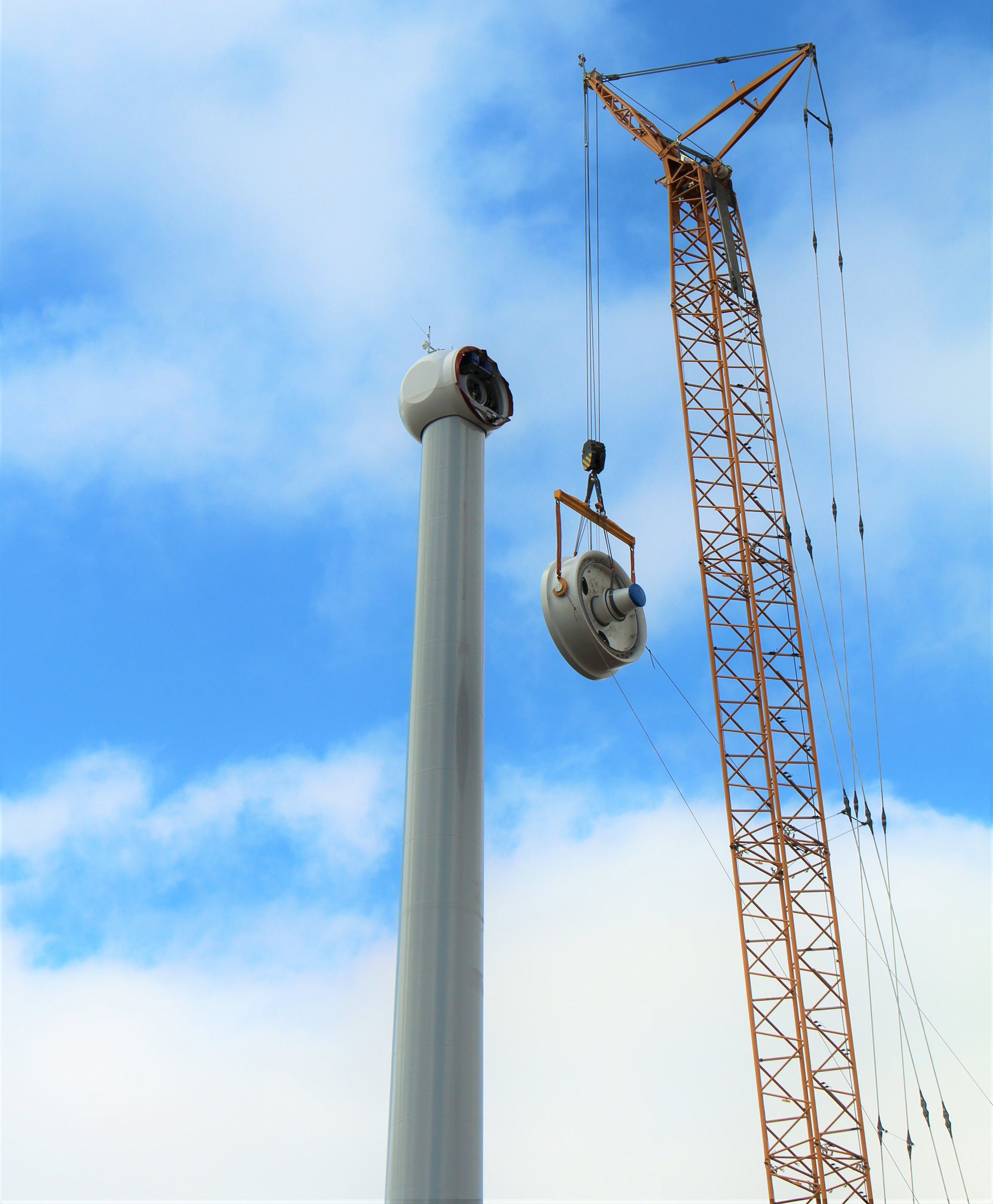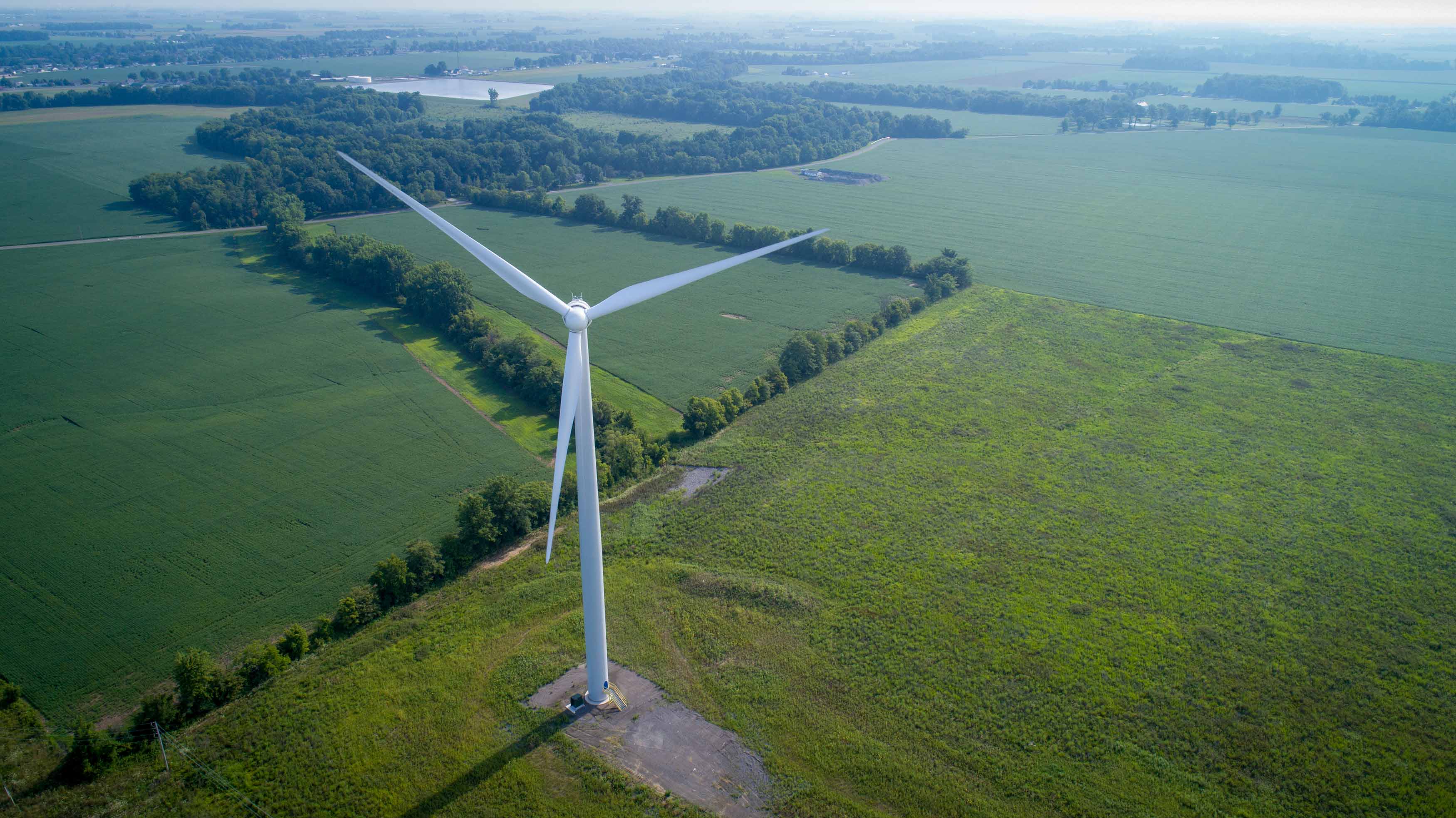SITE PATH
ONE ENERGY FEED

SUBSCRIBE
CONNECT WITH US
News Filters

How fast can wind turbines spin? We get asked that a lot!
The maximum speed a turbine can spin – or more specifically, the maximum speed at the tip of spinning wind turbine blades – depends on the turbine. Wind turbine manufacturers provide all owners with information on how many rotations the rotor (three blades and a hub) on their specific turbine model can complete per minute, when generating at full capacity.
Our turbines at the North Findlay Wind Campus complete 16 rotations per minute at full capacity. And their maximum blade tip speed is 163 miles per hour!
At full capacity and maximum speed, these wind turbines are generating their highest amounts of electricity – and directly powering manufacturers in our communities!

Think that’s pretty cool? Share it on Facebook, LinkedIn, Instagram, and Twitter!

Wind Study answer time! On Monday, we asked you to calculate the radius for a crane lift, and whether it would be considered a “critical pick” during wind turbine construction.
With components weighing hundreds of thousands of pounds, these details are crucial for the One Energy team and our crane operators to know. Think you know the answers? Find out below! (If you haven’t read Monday’s question yet, click here.)
The answers to these questions can be downloaded via the link below.
Download this week’s Wind Study Homework Answer
Below, a different view of a crane lifting a wind turbine generator during construction of a One Energy Wind for Industry project. (Look closely – can you see the wind energy technician inside the nacelle, ready to receive the component? Don’t worry – they’re harnessed in safely!)

Check back on Monday for a new Wind Study question, which will be posted to our Facebook and Twitter accounts as well!

What’s the difference between an economist and an accountant? The economist didn’t have enough personality to be an accountant.
Of course, this joke is funny because everyone knows that accounting is boring and thus, accountants are, too…right? Therefore, economists must be even worse!
Really, I just think the accounting industry has a branding issue. Why not call ourselves Scorekeepers? It would certainly make us sound more interesting. And in the end, keeping score is really what we’re doing. Capturing lots of data, nearly all in dollars, and spitting it out in some form of useful information that tells you something about your business. How much does it cost us to add a truck to our fleet of vehicles? How much should we charge for this new product? If we hire five new employees, what will that cost us “all in” (including all the benefits and taxes)? And the ever popular, “Did we make any money?”
The “art” of accounting, however, isn’t about answering those questions. It’s about presenting information in a way that is understandable, meaningful, useful, and valuable. Doing that requires a genuine understanding of your audience and a real appreciation for the fact that different audiences need different information presented in different ways. Different people in different positions will find different sets of information useful. The art of accounting is meeting the needs of your different audiences so that they, in turn, can make critical decisions that propel your organization forward. It’s the difference between reading the black and white box score in the sports section of the newspaper (boring!) and listening to a talented announcer describe the last play of the game as one team comes from behind to score in the last few seconds, pulling out an unbelievable win!
Accounting isn’t sexy. Well, not to most people. (Okay, honestly, not even to me.) But try thinking about any professional sporting event without the questions, “what’s the score?” or “who won?” crossing your mind. It’s like touching your nose with your elbow – you just can’t do it! (You can put your elbow down now.)
If you try thinking about financial statements or reports like a scorecard, perhaps they will be more interesting and maybe even less daunting! And if you think you need different information, more understandable information, or you don’t know how the information you’re getting applies to your job, then it’s probably time to have a conversation with your accountant. A good accountant will want to get you what you need, and a great accountant will find a way to make it interesting for you! I mean, we’re not economists, after all.
Anne Bain is the Head of Accounting at One Energy.

Today’s Wind View shows two wind turbine tower sections being stacked during construction. Once all four sections have been stacked, the tower will be roughly 265 ft. tall and ready to be topped with the nacelle!
Visit page 4.1 Energy Terminology to learn more about these turbine components (towers, nacelles, and much more!).


Happy Monday! In this week’s Wind Study we’re talking tables, metrics, and cranes capable of lifting hundreds of thousands of pounds!
To construct wind turbines, One Energy uses a crane to lift and install components, such as the generator pictured below (which weighs 101,200 pounds). For this week’s Wind Study, learn about “critical picks”, how to read tables and crane load charts, and help us answer two math problems about lifting components with a crane.
Download this week’s Wind Study Homework Question (and check back Friday for the answer!) This question can also be found on our Facebook and Twitter accounts.


This week’s view features our Wind for Industry project located in Ottawa, Ohio. Rather than sending power to the electric grid, this 1.5 MW utility-scale wind turbine directly powers a local manufacturing facility.


Introducing Technician Talk! Check back every month for a new tutorial from one of One Energy’s own wind technicians. Learn a new skill, get to know our gear, watch us complete a task, and meet the crew! Get down to the nitty gritty of building a Wind for Industry project! This week, we’re learning from OE Technician Justin Bruns.
Curious why wind turbines (and other tall structures) flash red at night?
Those red blinking lights are called FAA Obstruction Lights – FAA stands for the Federal Aviation Administration. These lights help illuminate tall structures, such as wind turbines, so that aircraft can easily identify and avoid them.
Justin will explain all about FAA lights – and what happens if an FAA light stops functioning on a wind turbine.
To catch future Technician Talks, subscribe to our You Tube channel!

Ever wonder what makes a wind turbine spin?
Your hosts Hans and Josh will tackle that common question in this latest installment of One Energy’s Science Shorts – the series where we explore all things science and STEM!
Learn what aerodynamic forces are, and how one force in particular – lift – enables both airplane travel and the movement of wind turbine blades. Hans and Josh, interns at One Energy, will explain how blades are designed to “catch the wind,” and will share an up-close view of a wind turbine blade.
To catch future Science Shorts, subscribe to our YouTube channel.

Wind turbine construction jobs are not for the weak of heart. The long working hours and ever-changing whereabouts can trigger discord with work-life balance. Construction is also a risky business. Not only can these jobs take a toll on one’s home life, but they require physical activity beyond a typical desk job, as well as presence of mind each and every day. If you have an off day, the consequences can be fatal.
It’s common for construction companies to incentivize projects, to try to increase employee engagement and performance. With promotions, bonuses, and additional time off, there is encouragement to perform work ahead of schedule and under budget. While incentives may seem like a great answer, they can quickly create a perilous work environment of cutting corners and making decisions without logic.
The pressure or longing to complete tasks quickly can often outweigh the necessity of completing tasks safely and correctly. The easy answer to combat this incentivized risk is to add checks and balances through third parties and/or in-house teams. While that is prudent and necessary, it doesn’t solve the entire problem. These checks and balances don’t always have the necessary authority, silos can develop, toxic work environments can fester, and all kinds of problems can arise.
So how do you combat mistakes and ensure safety, while enabling innovation?
One Energy is the largest installer of on-site wind in the U.S. After several years of performing traditional construction management services, we strategically moved to self-perform all aspects of the construction process. (Meaning, we use in-house labor to install all civil, foundation, electrical, and erection work.) Over the last decade, we’ve learned that it is possible to innovate – to become faster, leaner, and more efficient – without incentivizing risk or sacrificing safety and/or quality.
Here’s how we do it:
- Robust training and cross-training. Our daily decisions are often made in a vacuum, with employees instinctively assessing “How will this affect me and what I am accomplishing in this moment?” While those questions are important, team members must also think about the parts of the overall process that are affected by missteps. Train your employees to be effective in their roles, but also invest in cross-training, so employees see the bigger picture.
- Employees need breaks and clear expectations. An employee who shows grit is great, but I need our team members to stay engaged for their entire careers. Burnout is real. Set boundaries and expectations for employees in their roles – including time away from the job.
- Spend time finding the right hires. Hiring is difficult and finding people when you need them is even more challenging. Some of the best potential hires are people you already have a working relationship with. You might be surprised by the places we’ve found brilliant hires, from waitstaff at a local restaurant to fellow gym members. Get to know people. Get to know your industry. Spend time finding the right fit and remember that it doesn’t always have to happen overnight, and it doesn’t have to be typical.
- Celebrate the wins and analyze the losses. Rewarding people for a job well done is a great way to take care of them, whether it’s company-wide or on an individual basis. However, when something doesn’t go well, don’t shy away from the conflict. Address it, learn from it, and move on, rather than avoiding the conversation or ignoring it outright.
- Allow ALL employees to innovate (in a controlled environment). Innovation is not something many companies allow at all levels, but it must be a priority in construction. Allow for and encourage the free flow of information – but make sure implementation is strategic and deliberate, with alignment at all levels.
- Vertically integrate. Build a team that can rally around each other. Our teams are part of the process from green field to operational project, and there is a lot of pride in participating at (and completing) each stage. Build and develop a team that wants to take on the world – from start to finish.
- Empower employee fulfillment. Employment is selfish by nature; we all work to get paid and to feel fulfilled. Money is nice, but fulfillment is the goal. Take good care of the people who take good care of your business.
Too many construction crews get into a “finish at all costs” mentality and lose their field of vision. It’s easy to let one thing slide, and then another, and another. Sliding into that culture could cost some teams a lot more than money. Make sure that team is not yours.
Chelsea Bumb is the Head of Construction at One Energy.



